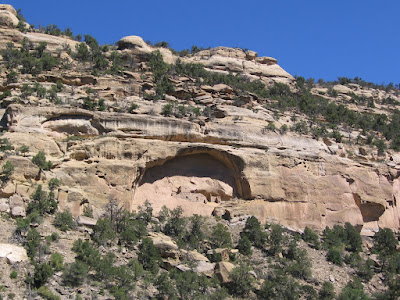The Mesa Top Pit House to Pueblo Tour is a ten stop self guided tour that traces the development of building styles at Mesa Verde National Park in southwest Colorado. During the busy summer, most visitors will move their vehicles between the stops.
In winter, the segment between the Square Tower House Overlook and the Sun Point Overlook is a 3 mile round trip hike on a hard surface that is cleared of snow and free from mud. One of the dozen or so ruins structures visible at Sun Point is the mysterious Sun Temple, visible on a point to the left of the famous Cliff Palace. It is another 0.5 miles of road past Sun Point to arrive at the Sun Temple.
Visitors enter the site from the west side and circle around to the south side. It is hard to see, but the overall structure is D shaped, has thick walls and most of the structure has a row of narrow rooms around the outside. On the south side, there is an indent in the wall with a small square opening on each side.
Looking in through the small openings, there are views on each side of the line of connected small rooms. There aren’t any apparent exterior doorways anywhere around the whole building.
Outside the southeast corner of the Sun Temple, there is a large circular tower. Along this same side, there is a good view of the Cliff Palace across the canyon.
There is a rock outcrop on the north side of Sun Temple that allows a view over the walls. On the interior, there is an open area with two circular kivas. No roof materials or household goods were found here, and it appears that this structure wasn’t completed before the entire region was abandoned around 1300 AD.
There is a rock outcrop on the north side of Sun Temple that allows a view over the walls. On the interior, there is an open area with two circular kivas. No roof materials or household goods were found here, and it appears that this structure wasn’t completed before the entire region was abandoned around 1300 AD.
















































